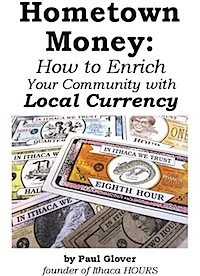






 |
 |
 |
 |
 |
  |
| PAUL
GLOVER ESSAYS: community
control of food, fuel, housing, health care,
planning, education, finance. |
| HOME | INTRO | CURRENCY | SUCCESSES | HOW-TO BOOK | PUBLICITY | ESSAYS |
|
Los
Angeles Dry and High
by Paul Glover, October 2014 Total transformation is the Los Angeles style. Just two hundred years ago this place sheltered hunter-gatherers who danced the porpoise dance. Within sixty years they were trampled by Spaniards and their half million cattle. Thirty years later Anglos evicted the Spanish and plowed up pasture for wheat. Thirty years after that the wheat yielded to giant orchards. Another fifty years saw this food torn out for factories and homes. The latest fifty years have raised skyscrapers, freeways and a new Latino majority. Today another transformation is due. Los Angeles carries water across hundreds of miles of dry land in the world's longest aqueducts, to prevent slow death by drought. But we're sucking these straws dry. During the past thirty years, Hollywood movies have projected Los Angeles exploding, cracking, sinking, freezing, or overrun by volcanos, tyrannosaurs, robots, sharks, extraterrestrials or zombies. Yet no film has featured our looming apocalypse of brittle air. As thirst rises, the LADWP is chasing Sierra raindrops. Yet, during a 20-year drought or climate shift, water rationing alone might not suffice. Nor would drought-tolerant lawns, low-flush toilets, greywater systems, pool covers, industrial water recycling, or surcharges. The above are Plan A, essential beginnings.  Thirty
years ago, as founder of Citizen
Planners of Los Angeles, I published a Severe Extended
Drought (SED) plan. During these dusty times, perhaps it's time to dust
it off. SED invites us to embrace the unthinkable-- to rebuild
Los
Angeles yet again, so that our metropolis thrives with one
tenth of
current fresh water use. It presents a metropolis wholly different from
the one we know, because chronic drought binds us to great change. The
technology, money, and creativity to do this exist. Thirty
years ago, as founder of Citizen
Planners of Los Angeles, I published a Severe Extended
Drought (SED) plan. During these dusty times, perhaps it's time to dust
it off. SED invites us to embrace the unthinkable-- to rebuild
Los
Angeles yet again, so that our metropolis thrives with one
tenth of
current fresh water use. It presents a metropolis wholly different from
the one we know, because chronic drought binds us to great change. The
technology, money, and creativity to do this exist.TECHNOLOGY: Just like spaceships, cities need backup systems. Thus these boldest proposals, offering orderly transitions, could soon become urgent. They preserve us when made top priority. Here is the summary: Homes consume 60% of the region's water. Since our flush toilets use 30% of indoor water, we'll replace flushers with waterless biodigesters that convert poop into distilled water, methane fuel, and safe sweet-smelling soil. |
Seattle
boasts a six-story office building without flushers. And
several cities
already collect urine to use as fertilizer (EcoSanRes, TepozEco,
ArborLoo). Washing
clothes consumes 18% of
household water, which can be cut 90% by xerostatic processes. All
storm sewers should redirect into recharge, to bioremediate
groundwater. During rare downpours, nothing should escape to the sea.
Every such diversion reduces water wasted through pumping (8%
countywide use) and leakage (18%). During the next decades, new solar housing will need no fossil fuel for pumping water, nor for heating or cooling. Consolidation of population into these attractive 3-story "ecolonies" releases land for greenhouses and play. All these structures are fully fireproof, so flame spraying (3% total use) ends. As ecolonies gradually replace tall dull walls, greenhouses would fill half the spaces between, to recycle evapotranspiration. Green roofs on ecolonies, and orchards between them, cool the air naturally. Shade vine canopies would cover mosaic pathways. There is such potent soil under our pavement that this county was the greatest garden in the United States, between 1910 and 1950. The ocean desalted is an endless supply, as Santa Barbara and San Diego already know. Solar trough concentrators, wave motors, and airborne wind generators can extensively power purification. Fish larvae protection and other environmental hazards must first be solved. Brine yields gypsum, calcium, nitrates and magnesium. SED's ultimate heresy is to replace cars with trollies and bicycles. As L.A.'s rigid street grid yields to graceful rail contours, water supply expands several ways. Reduction of paving through Progressive Street Reclamation permits more planting and more groundwater recharge, which further dissolves the urban heat island. Resultant cooler city air attracts clouds. MONEY: To gather capital for this water renaissance, we can establish the Los Angeles Stock Exchange Reservoir (LASER), which creates and allocates regional credits. Such investment is a bargain, to preserve property values. Yet the job can't be done primarily by trickle-down. Decentralized technologies decentralize control of money, land and law, which sparks an economy both more profitable and more fair. Neither capitalist nor socialist, it's a "mutual enterprise" system that feeds wealth to relevant businesses and nonprofits. PEOPLE: Los Angeles deserves new movies for a new era. We need stories that celebrate the talents of our people, and our pride in working together to construct this future. We can enjoy a city as sustainable as a forest, as friendly as a family dinner, and as beautiful as our children. Glover is author of "Los Angeles: A History of the Future," and taught urban studies at Temple University. He is founder of a dozen organizations dedicated to ecology and social justice. [email protected] 215 805-8330 |
 |
 |
 |
 |
 |
 |